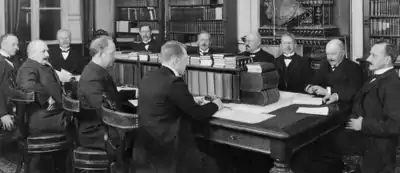Karl Staaff
Karl Albert Staaff (21 January 1860 – 4 October 1915) was a Swedish liberal politician and lawyer. He was chairman of the Liberal Coalition Party (1907–1915) and served twice as Prime Minister of Sweden (1905–1906 and 1911–1914).[2]
Karl Staaff | |
|---|---|
 | |
| Prime Minister of Sweden | |
| In office 7 November 1905 – 29 May 1906 | |
| Monarch | Oscar II |
| Preceded by | Christian Lundeberg |
| Succeeded by | Arvid Lindman |
| In office 7 October 1911 – 17 February 1914 | |
| Monarch | Gustaf V |
| Preceded by | Arvid Lindman |
| Succeeded by | Hjalmar Hammarskjöld |
| Personal details | |
| Born | 21 January 1860 Stockholm, United Kingdoms of Sweden and Norway |
| Died | 4 October 1915 (aged 55) Stockholm, Sweden |
| Political party | Free-minded National Association[1] |
| Spouse | None |
From 1897 to 1915 Staaff was a member of the Riksdag's Andra kammar, Parliament's lower house.[3] Staaff was active in the Swedish movement for universal suffrage, and as the Liberal party's Prime Minister he presided in 1905 over an attempt to introduce universal and equal suffrage for men. His successor as party leader, Nils Edén, eventually managed to carry this further into universal suffrage in 1918–1919, including for women. Due to conservative intervention, Staaff's proposal for first-past-the-post voting was ultimately scrapped for a proportional system. In 1912, the period of leave that women were allowed following a child's birth was extended to six weeks, and in 1913 a tax-financed pension scheme was introduced.[4]
Staaff ran into sharp conflict with the conservative Swedish establishment, and became a hated figure in the conservative, pro-monarchic and anti-democratic establishment. An intense smear campaign was launched against him, picturing him as the destroyer of Swedish tradition and society: wealthy Stockholmers could even buy ashtrays shaped as his head. His staunch anti-military politics led to the greatest fundraiser up to that time in Swedish history – funds for the 12 million kronor coastal battleship HSwMS Sverige were raised in 1912 in just a few months. Staaff had to bite the bullet, and the ship was ordered.
In 1914 Staaff stepped down from the government in protest after the conservatives had summoned a farmers' demonstration at the Royal castle's court in Stockholm, where King Gustaf V – who according to law was supposed to stay out of politics – denounced Staaff's defence policies.
The contemporary Swedish Liberal party the Liberals count him as the first among the more prominent leaders of Swedish 20th-century liberalism, followed by such parliamentarians as Nils Edén, Carl Ekman, Nobel Prize laureate Bertil Ohlin, Gunnar Helén, Per Ahlmark and Bengt Westerberg.

References
- Nohlen & Stöver, p1861
- "Sweden" (in Swedish). World Statesmen. Retrieved 22 December 2014.
- Torbacke, Jarl. "Karl A Staaff". Svenskt Biografiskt Lexikon (in Swedish). Retrieved 2023-04-03.
- Foundations of the Welfare State: 2nd Edition by Pat Thane, published 1996